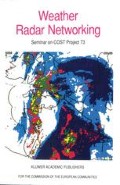Summary
The range of weather radars is restricted by the curvature of the earth and by blocking of the radar beam behind obstacles. Each radar has its own typical horizon, which may have a large influence on the quality of the data, especially at far range. Radar horizon data are important for the planning of new sites and also for the interpretation and the presentation of measurements by single radars or radar networks.
The COST-73 Management Committee has agreed on a standard method for obtaining and archiving radar horizon data in the participating countries. As a result the production of a radar coverage map of a large part of Europe is scheduled. This map will show the areas where operational digitized radars may detect precipitation reaching to a level of 1500 m above the ground. This information is useful for the development of merging algorithms in overlap regions between radars. The map will also indicate where the bilateral exchange of data is beneficial for improved detection or for back-up purposes. Finally such a map may serve to assess the local quality of COST radar composites.
Access this chapter
Tax calculation will be finalised at checkout
Purchases are for personal use only
Preview
Unable to display preview. Download preview PDF.
References
CLIFT, G.A. (1985). Use of radar in meteorology. WMO Technical Note Nr.181., Geneva, 90 pp.
LARKE, P.R. and COLLIER, C.G. (1981). Merging data from several weather radars, in: Workshop/Seminar on the European weather radar project, Reading, Malvern (UK), 141–158.
MARTINEZ, C. (1985). The Spanish radar network project. In: Proceedings COST-72 Final Seminar, Erice (It), Measurement of precipitation by radar, Report EUR 10353, 191–198.
LEONE, D.A., ENDLICH, R.M., PETRICEKS, J., COLLIS, R.T.H. and PORTER, J.R. (1989). Meteorological considerations used in planning the NEXRAD network. Bull, of the American Meteor. Soc., 70, 4–13.
JOSS, J. and WALDVOGEL, A. (1987). Precipitation measurement and hydrology. Arbeitsber. Schweiz. Meteor. Zentr. Anstalt
STEWART, J.B. (1964). Precipitation from layer cloud. Quarterly Journal of the Roy. Met. Soc., 90, 287–297.
TURTON, J.D., BENNETTS, D.A. and FARMER, S.F.G. (1988). An introduction to radio ducting. Meteorological Magazine, 117, 245–254
BEAN, B.R. and DUTTON, E.J. (1968). Radio Meteorology. Dover, New York, 435 pp.
Author information
Authors and Affiliations
Editor information
Editors and Affiliations
Rights and permissions
Copyright information
© 1990 ECSC, EEC, EAEC, Brussels and Luxembourg
About this chapter
Cite this chapter
Wessels, H.R.A. (1990). Estimation of the Areal Coverage of Radars and Radar Networks from Radar Site Horizon Data. In: Collier, C.G., Chapuis, M. (eds) Weather Radar Networking. Springer, Dordrecht. https://doi.org/10.1007/978-94-009-0551-1_23
Download citation
DOI: https://doi.org/10.1007/978-94-009-0551-1_23
Publisher Name: Springer, Dordrecht
Print ISBN: 978-94-010-6735-5
Online ISBN: 978-94-009-0551-1
eBook Packages: Springer Book Archive

